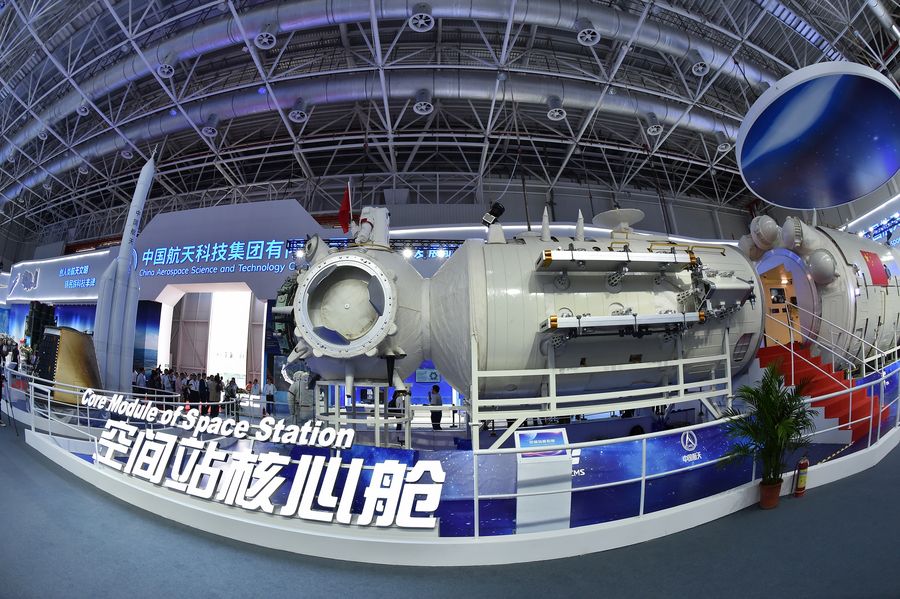
A full-size model of the core module of China's space station Tianhe exhibited at the 12th China International Aviation and Aerospace Exhibition (Airshow China) in Zhuhai, south China's Guangdong Province, Nov. 5, 2018. (Xinhua/Liang Xu)
China aims to complete construction of the space station around 2022. More than 10 missions are planned in the next three years to complete the construction and master technologies for in-orbit assembly and construction of large complex spacecraft, long-term manned spaceflight in near-Earth space and large-scale space science experiments.
BEIJING, Feb. 20 (Xinhua) -- The maiden flight of the Long March-5B rocket carrying a trial version of China's new-generation manned spaceship is expected to take place in April, indicating the imminent start of construction of China's space station.
The rocket, the prototype core capsule of the space station and the experimental manned spaceship are undergoing tests at the Wenchang Space Launch Center on the coast of south China's island province of Hainan.
During the flight in mid to late April, the experimental manned spaceship will be sent into space with no crew. The prototype of the core capsule of the space station will not be launched.
The Long March-5B is a modified version of the Long March-5, currently China's largest carrier rocket, and will be mainly used for sending capsules of China's space station and large spacecraft to the low-Earth orbit, according to the China Manned Space Agency (CMSA).
Space engineers developed a new large fairing, which is 20.5 meters long and 5.2 meters in diameter, for the Long March-5B. The whole rocket is about 53.7 meters long, with a 5-meter diameter core stage and four 3.35-meter diameter boosters.
The rocket uses environment-friendly fuel, including kerosene, liquid hydrogen and liquid oxygen. It has a takeoff weight of about 849 tonnes and a payload capacity of 22 tonnes to low-Earth orbit, said Wang Jue, chief director of the Long March-5 development team at the China Academy of Launch Vehicle Technology under the China Aerospace Science and Technology Corporation.
After the maiden flight of the Long March-5B, the Long March-5 carrier rocket will launch China's first Mars probe and the Chang'e-5 lunar probe later this year.

The trial ground of an experiment for landing on Mars in Huailai County, north China's Hebei Province, Nov. 14, 2019. On Nov. 14, China unveiled an experiment simulating the process of a probe hovering, avoiding obstacles and descending to land on Mars. (Xinhua/Jin Liwang)
China aims to complete construction of the space station around 2022. According to the CMSA, more than 10 missions are planned in the next three years to complete the construction and master technologies for in-orbit assembly and construction of large complex spacecraft, long-term manned spaceflight in near-Earth space and large-scale space science experiments.
China still faces many challenges, so joint drills at the space launch center and the maiden flight of the Long March-5B are very important, said experts.
The space station will be a T shape with the Tianhe core module at the center and a lab capsule on each side. The core module -- at 16.6 meters long and 4.2 meters in diameter, with a takeoff weight of 22.5 tonnes -- will be the management and control center.
China's current largest spacecraft, the Tianhe core module will be able to support a long-term stay of three astronauts in space.
The living space in the core module is about 50 cubic meters. With the two lab capsules, the living space could be up to 110 cubic meters, which would provide the astronauts a confortable environment, said experts from the China Academy of Space Technology (CAST), the main developer of the space station capsules.
The longest stay in space so far by Chinese astronauts is 33 days. The necessary water and oxygen were taken into space. To enable astronauts to stay longer in orbit, the space station will be equipped with a renewable life support system, said experts.
The water vapor exhaled by astronauts will be recovered by condensation, and urine will be recycled and purified as drinking water and domestic water. The hydrogen produced in electrolytic oxygen production and the carbon dioxide exhaled by astronauts can generate oxygen through chemical reaction, which can supplement oxygen for the space station.
Science facilities on the space station could support hundreds of research projects in fields such as astronomy, space life science, biotechnology, microgravity, basic physics and space materials.
More than a dozen advanced experiment racks will be installed, and an extra-vehicular experiment platform will be built. In addition, a capsule holding a large optical telescope will fly in the same orbit.
The manned spaceship is being developed for the operation of the space station and future manned lunar exploration missions, said experts from CAST.
With a length of 8.8 meters and a takeoff weight of 21.6 tonnes, the spaceship will be able to carry six astronauts. It is designed for safety and reliability, and can adapt to multiple tasks. The return capsule is reusable.
Since the spaceship will be used in both low-Earth orbit and deep space exploration, the design of its structure and thermal protection will be a great challenge, said experts.
The mission in April will test the key technologies of the spaceship, according to CAST.
In 1992, China started its manned space program with a three-step strategy.
Yang Liwei carried out the first step - to send an astronaut into space and return safely - in the Shenzhou-5 mission in 2003.
The second step was developing advanced space flight techniques and technologies including extra-vehicular activity and orbital docking. This phase included the launch of Tiangong-1, a transitional platform to test the docking technology, and Tiangong-2 space lab.
So far, China has launched 11 manned spacecraft, one cargo spacecraft, Tiangong-1 and Tiangong-2, sending 11 astronauts into space, completing the first two steps of the manned space program.
The next step will be to assemble and operate a permanent manned space station. ■



